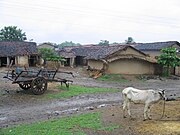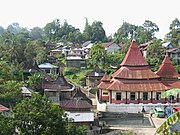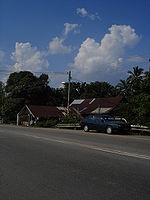Village
A village is a clustered human settlement or community, larger than a hamlet, but smaller than a town or city[1]. Though generally located in rural areas, the term urban village may be applied to certain urban neighbourhoods, such as the West Village in Manhattan, New York City and the Saifi Village in Beirut, Lebanon. Villages are normally permanent, with fixed dwellings; however, transient villages[2] can occur. Further, the dwellings of a village are fairly close to one another, as against being scattered broadly over the landscape (‘dispersed settlement’).
Villages have been the usual form of community for societies that practice subsistence agriculture, and even for some non-agricultural societies. Towns and cities were few, and were home to only a small proportion of the population. The Industrial Revolution caused many villages to grow into towns and cities; this trend of urbanisation has continued, though not always in connection with industrialisation. Villages have thus been eclipsed in importance, as units of human society and settlement.
Traditional villages
Although many patterns of village life have existed, the typical village was small, consisting of perhaps 5 to 30 families. Homes were situated together for sociability and defense, and land surrounding the living quarters was farmed.
South Asia
India

"The soul of India lives in its villages", declared M. K. Gandhi [3] at the beginning of 20th century. According to the 2001 Indian census, 74% of Indians live in 638,365 different villages.[4] The size of these villages varies considerably. 236,004 Indian villages have a population less than 500, while 3,976 villages have a population of 10,000+. Most villages have their own temple, mosque or church depending on the local religious following.
Southeast Asia
Brunei, Indonesia and Malaysia
The term kampung in the English language has been defined specifically as "a Malay hamlet or village in a Malay-speaking country" [5] In other words, a kampung is defined today as a village in Brunei, Indonesia or Malaysia. In Malaysia, a kampung is determined as a locality with 10,000 or fewer people. Since historical times, every Malay village came under the leadership of a penghulu (village chief), who has the power to hear civil matters in his village (see Courts of Malaysia for more details). A Malay village typically contains a "masjid" (mosque) or "surau" (Muslim chapel), stilt houses and paddy fields. Malay and Indonesian villagers practice the culture of helping one another as a community, which is better known as "joint bearing of burdens" (gotong royong)[6], as well as being family-oriented (especially the concept of respecting one's family [particularly the parents and elders]), courtesy and believing in God ("Tuhan") as paramount to everything else. It is common to see a cemetery near the mosque, as all Muslims in the Malay or Indonesian village want to be prayed for, and to receive Allah's blessings in the afterlife.
Philippines
In urban areas of the Philippines, the term "village" most commonly refers to private subdivisions, especially gated communities. These villages emerged in the mid-twentieth century and were initially the domain of elite urban dwellers. However, they are now common in Metro Manila and other major cities in the country and their residents can have a wide range of income levels. They may or may not correspond to administrative units (usually barangays) and/or be privately administered. Some examples of well-known villages in Metro Manila are Forbes Park and Dasmariñas Village.
Vietnam
Village, or "làng", is a basis of Vietnam society. Vietnam's village is the typical symbol of Asian agricultural production. Vietnam's village typically contains: a village gate, "lũy tre" (bamboo hedges), "đình làng" (communal house) where "thành hoàng" (tutelary god) is worshiped, "đồng lúa" (rice field), "chùa" (temple) and houses of all families in the village. All the people in Vietnam's villages usually have a blood relationship. They are farmers who grow rice and have the same traditional handicraft. Vietnam's villages have an important role in society (Vietnamese saying: "Custom rules the law" -"Phép vua thua lệ làng" [literally: the king's law yields to village customs]). Everyone in Vietnam wants to be buried in their village when they die.
North America
United States
Incorporated villages
- See also: Administrative divisions of New York#Village and Village (Oregon)
In twenty[10] U.S. states, the term "village" refers to a specific form of incorporated municipal government, similar to a city but with less authority and geographic scope. However, this is a generality; in many states, there are villages that are an order of magnitude larger than the smallest cities in the state. The distinction is not necessarily based on population, but on the relative powers granted to the different types of municipalities and correspondingly, different obligations to provide specific services to residents.
In some states such as New York, Wisconsin, or Michigan, a village is an incorporated municipality, usually, but not always, within a single town or civil township. Residents pay taxes to the village and town or township and may vote in elections for both as well. In some cases, the village may be coterminous with the town or township. There are also many villages which span the boundaries of more than one town or township, and some villages may even straddle county borders.
There is no limit to the population of a village in New York; Hempstead, the largest village in the state, has 55,000 residents, making it more populous than some of the state's cities. However, villages in the state may not exceed five square miles (13 km²) in area.
In the state of Wisconsin a village is always legally separate from the township(s) that it has been incorporated from. The largest village is Menomonee Falls, which has over 32,000 residents.
Michigan and Illinois also have no set population limit for villages and there are many villages that are larger than cities in those states.
Villages in Ohio are almost always legally separate from any townships that they may have been incorporated from (there are exceptions, such as Chagrin Falls, where the township includes the entirety of the village). They have no area limitations, but must reincorporate as cities if they grow to over 5,000 in population. Villages have the same home-rule rights as cities with fewer of the responsibilities. Unlike cities, they have the option of being either a "statutory village" and running their governments according to state law (with a six-member council serving four-year terms and a mayor who votes only to break ties) or being a "charter village" and writing a charter to run their government as they see fit.
[citations needed]
In Maryland, a locality designated "Village of ..." may be either an incorporated town or a special tax district.[11] An example of the latter is the Village of Friendship Heights.
In states that have New England towns, a "village" is a center of population or trade, including the town center, in an otherwise sparsely-developed town or city — for instance, the village of Hyannis in the city of the Town of Barnstable. Although over the years the village has become more like a small town within a town with it now being the center of everything for Barnstable.
Unincorporated villages
In many states, the term "village" is used to refer to a relatively small unincorporated community, similar to a hamlet in New York state. This informal usage may be found even in states that have villages as an incorporated municipality, although such usage might be considered incorrect and confusing.



